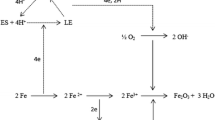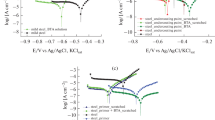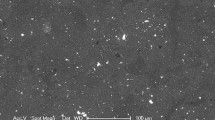Abstract
The aim of this work was to provide a first description of the behaviour of diethyl phosphite in organic coatings, description of their physico-mechanical properties as well as anticorrosion properties in the protection of steel substrates. The diethyl phosphite behaviour in the organic coatings depends on the volume concentration of the pigment. A polyaniline base was suspended in diethyl phosphite as a new reactant. The pigment so prepared was used as a corrosion inhibitor in model paints containing a solvent-based epoxy-ester resin as the binder. The organic coatings were applied to steel panels and to glass panels and subjected to mechanical tests, corrosion resistance tests and electrochemical tests. Furthermore, they were exposed to the environments of condensed steam, neutral salt solution mist, and sulphur dioxide-containing mist. The corrosion effects were evaluated and the organic coatings’ overall anticorrosion efficiency was calculated from the results. Ultimately, the optimum pigment volume concentration (PVC) at which the coatings provided the best anticorrosion protection was determined: it was PVC = 10 vol%, whereas the best mechanical resistance was observed at PVC = 5 vol%. The goal of the forthcoming work will be to optimise all the properties into a single pigment volume concentration.












Similar content being viewed by others
Abbreviations
- B:
-
Benzoid structure
- CMX:
-
Continuous measurement of X
- D:
-
Dense (the highest frequency of the blistering of paint)
- DEPh/PANI:
-
Diethylphosphite with polyaniline base
- DEPh/PANI_10:
-
Coating of diethyphosphite with polyaniline base with PVC = 10 vol%
- DEPh/PANI_15:
-
Coating of diethyphosphite with polyaniline base with PVC = 15 vol%
- DEPh/PANI_17:
-
Coating of diethyphosphite with polyaniline base with PVC = 17 vol%
- DEPh/PANI_5:
-
Coating of diethyphosphite with polyaniline base with PVC = 5 vol%
- DFT:
-
Dry film thickness
- EB:
-
Emeraldine base
- E DEPh/PANI_1 :
-
Young’s modulus of diethyphosphite with polyaniline base with PVC = 1%
- EDX:
-
Energy-dispersive X-ray spectroscopy
- E HCl/PANI :
-
Young’s modulus of polyaniline hydrochloride
- E nER :
-
Young’s modulus of nonpigmented epoxy-ester resin
- ES:
-
Emeraldine salt
- F :
-
Few (the lowest frequency of the blistering)
- HCl/PANI:
-
Paint of polyaniline hydrochloride
- K m :
-
Corrosion loss reduction %
- M:
-
Medium (frequency of the blistering of paint)
- MD:
-
Medium dense (frequency of the blistering of paint)
- M ws,c :
-
Presence of substances soluble in cold water %
- M ws,h :
-
Presence of substances soluble in hot water %
- PANI:
-
Polyaniline
- Q:
-
Quinoid structure
- rpm:
-
Rotate per minute
- SEM:
-
Scanning electron microscope
- UV:
-
Ultraviolet
- x :
-
Titration share of substances soluble in hot water g L−1
- ρ :
-
Density of pigments g cm−3
- Corr:
-
Corrosion
- DEPh/PANI_1:
-
Coating of diethyphosphite with polyaniline base with PVC = 1 vol%
- DEPh/PANI_3:
-
Coating of diethyphosphite with polyaniline base with PVC = 3 vol%
- HCl/PANI:
-
Polyaniline hydrochloride
- m:
-
Loss reduction
- nER:
-
Nonpigmented epoxy-ester resin
- R:
-
Rate
- ws,c:
-
Soluble in cold water
- ws,h:
-
Soluble in hot water
References
ASTM International (2000) United States standard: standard test method for evaluation degree of blistering of paints. ASTM D 714. West Conshohocken
ASTM International (2008) United States standard: standard test method for evaluating painted or coated specimens subjected to corrosive environments. ASTM D 1654-92. West Conshohocken
ASTM International (2012) United States standard: practice for evaluation degree of rusting on painted steel surfaces. ASTM D 610-85. West Conshohocken
ASTM International (2013) United States standard: standard practice for conducting a test of protective properties of polish applied to a painted panel using fluorescent UV-condensation light- and water-exposure apparatus. ASTM D 1654-92. West Conshohocken
Ates M, Topkaya E (2015) Nanocomposite film formations of polyaniline via TiO2. Ag. and Zn. and their corrosion protection properties. Prog Org Coat 82:33–40. doi:10.1016/j.porgcoat.2015.01.014
Ayad MM, Shenashin MA (2003) Film thickness studies for the chemically synthesized conducting polyaniline. Eur Polymer J 39:1319–1324. doi:10.1016/S0014-3057(03)00033-8
Ayad MM, Zaki EA (2008) Dping of polyaniline films with organic sulfonic acids in aqueous media and the effect of water on these doped films. Eur Polymer J 44:3741–3747. doi:10.1016/j.eurpolymj.2008.08.012
Bedekar AG, Patil SF, Patil RC, Vijayamohanan K (1997) Effect of monomer concentration and substrate resistance on redox behaviour of polyaniline films. Mater Chem Phys 48:76–81. doi:10.1016/S0254-0584(97)80082-X
Chiang J-Ch, MacDiarmid AG (1986) ´Polyaniline´: protonic acid dopinf of the emeraldine form to the metallic regine. Synth Metal 13:193–205. doi:10.1016/0379-6779/86/90070-6
Cruz-Silva R, Romero-Garcia J, Angulo Sanchez JL, Flores-Loyola E, Farias HM, Castillon FF, Diaz AJ (2004) Comparative study of polyaniline cast films prepared from enzymatically and chemically synthesized polyaniline. Polymer 45:4711–4717. doi:10.1016/j.polymer.2004.05.007
Czech office for standards, metrology and testing (1994) Czech technical standardMatallic and other non-organic coatings. Sulfur dioxide test with general condensation of moisture. CSN ISO 6988. Praha
Czech office for standards, metrology and testing (1997a) Czech technical standard: general methods of test for pigments and extenders—Part 10: determination of density—pycnometer method. CSN ISO 787-10. Praha
Czech office for standards, metrology and testing (1997b) Czech technical standard: general methods of test for pigments and extenders—Part 5: determination of oil absorption value. CSN ISO 787-10. Praha
Czech office for standards, metrology and testing (1997c) Czech technical standard:. General methods of test for pigments and extenders—Part 9: determination of pH value of aqueous suspension. CSN ISO 789-9. Praha
Czech office for standards, metrology and testing (1997d) Czech technical standard: determination of oil absorption value. CSN 67 0531. Praha
Czech office for standards, metrology and testing (2001a) Czech technical standard:. General methods of test for pigments and extenders—Part 3: determination of matter soluble in water—hot extraction method. CSN ISO 789-3. Praha
Czech office for standards, metrology and testing (2001b) Czech technical standard:. General methods of test for pigments and extenders—Part 8: determination of matter soluble in water—cold extraction method. CSN ISO 789-8. Praha
Czech office for standards, metrology and testing (2002) Czech technical standard: Paints and varnishes—determination of resistance to humidity—Part 1: continuous condensation. CSN EN ISO 6270-1. Praha
Czech office for standards, metrology and testing (2003) Czech technical standard: general methods of test for pigments and extenders—Part 14: determination of pH resistivity of aqueous extract. CSN ISO 789-14. Praha
Czech office for standards, metrology and testing (2004) Czech technical standard: Paints and varnishes—designation of quantity and size of defects, and intensity of uniform changes in appearance. CSN EN ISO 4628. Praha
Czech office for standards, metrology and testing (2007a) Czech technical standard: paints and varnishes—determination of film thickness. CSN EN ISO 2808. Praha
Czech office for standards, metrology and testing (2007b) Czech technical standard: paints and varnishes—cupping test. CSN EN ISO 1520. Praha
Czech office for standards, metrology and testing (2007c) Czech technical standard: coating compositions. Determination of hardness of painting film by pendulum instrumen. CSN 67 3076. Praha
Czech office for standards, metrology and testing (2012a) Czech technical standard: Paints and varnishes—rapid-deformation (impact resistance) tests. CSN EN ISO 6272. Praha
Czech office for standards, metrology and testing (2012b) Czech technical standard: corrosion tests in artificial atmospheres—salt spray tests. CSN EN ISO 9227. Praha
Czech office for standards, metrology and testing (2013) Czech technical standard: paints and varnishes—cross-cut test. CSN EN ISO 2409. Praha
Czech office for standards, metrology and testing (2014) Czech technical standard: plastics—methods of exposure to laboratory light sources. CSN EN ISO 4892. Praha
Dispenza C, Sabatino MA, Deghiedy N, Casaletto MP, Spadaro G, Piazza S, Abd El-Rehim HA (2015) In-situ polymerization of polyaniline in radiation functionalized polypropylene films. Polymer 67:128–138. doi:10.1016/j.polymer.2015.04.038
Elkis AR, Gvozdenovic MM, Jugovic BZ, Stevanovic JS, Nikolic ND, Grgur BN (2011) Electrochemical synthesis and characterization of polyaniline thin film and polyaniline powder. Prog Org Coat 71:32–35. doi:10.1016/j.porgcoat.2010.12.004
Gong D, Dong W, Hu J, Zhang X, Jiang L (2009) Living polymerizatiom of 1.3-butadiene by a Ziegler-Natta type catalyst composed of iron(III) 2-ethylhexanoate, triisobualuminuum and diethyl phosphite. Polymer 50:2826–2829. doi:10.1016/j.polymer.2009.04.038
Huo LH, Cao LX, Wang DM, Cui HN, Zeng GF, Xi SQ (1999) Preparation and characterization of doped polyaniline. Thin Solid Films. doi:10.1016/S0040-6090(99)00293-X
Jafarzadeh S, Cleason PM, Sundell P-E, Tyrode E, Pan J (2016) Active corrosion protection by conductive composites of polyaniline a UV-cured polyester acrylate coatings. Prog Org Coat 90:154–162. doi:10.1016/j.porgcoat.2015.10.008
Kalendova A, Vesely D, Kohl M, Stejskal J (2014) Effect of surface treatment of pigment particles with polypyrrole and polyaniline phosphate on their corrosion inhibiting properties in organic coatings. Prog Org Coat 77:1465–1483. doi:10.1016/j.porgcoat.2014.04.012
Kulhánková L, Tokarsky J, Matejka V, Peikertova P, Vallova S, Mamulova Kutlakova K, Styskala V, Capkova P (2014) Electrically conductive and optically transparent polyaniline/montmorillonite nanocomposite thin films. Thin Solid Films 562:319–325. doi:10.1016/j.tsf.2014.05.006
Leymonie JP (2007) Phosphites and phosphates: When distributors and growers alike could get confused. Courtesy of New Ag International. http://www.spectrumanalytic.com/support/library/pdf/Phosphites_and_Phosphates_When_distributors_and_growers_alike_could_get_confused.pdf. Accessed 8 Dec 2016
Liu FT, Neoh KG, Kang ET, Li S, Han HS, Tan KL (1999) Effects of crosslink on polyaniline films doping behavior and degradation under weathering. Polymer 40:5285–5296. doi:10.1016/S0032-3861(98)00758-7
Liu XH, Xia ZD, Zhou H, Yuan B, Li Z, Guo F (2013) Corrosion behavior of different steel substrates coupled with conductive polymer under different serving conditions. J Iron Steel Res Int 20:87–92. doi:10.1016/S1006-706X(13)60147-8
Luo J, Wang X, Li J, Zhao X, Wang F (2007) Conductive hybrid film from polyaniline and polyurethane-silica. Polymer 48:4368–4374. doi:10.1016/j.polymer.2007.05.062
Motheo AJ, Santos RJ Jr, Venancio EC, Mattoso LHC (1998) Influence of different types of acidic dopant on the electrodeposition and properties of polyaniline films. Polymer 26:6977–6982. doi:10.1016/S0032-3861(98)00086-X
Mousavinejd T, Bagherzadeh MR, Akbarinezhad E, Ahmadi M, Guinel MJ-F (2015) A novel water-based epoxy coating using self-doped polyaniline-clay synthesized under supercritical CO2 condition for the protection of carbon steel against corrosion. Prog Org Coat 79:90–97. doi:10.1016/j.porgcoat.2014.11.009
Navarchian AH, Joulazadeh M, Karimi F (2014) Investigation of corrosion protection performance of epoxy coatings modified by polyaniline/clay nanocomposites on steel surfaces. Prog Org Coat 77:347–353. doi:10.1016/j.porgcoat.2013.10.008
Olad A, Nosrati R (2013) Preparation and corrosion resistance of nanostructured PVC/ZnO-polyaniline hybrid coating. Prog Org Coat 76:113–118. doi:10.1016/j.porgcoat.2012.08.017
Olad A, Rashidzadeh A (2008) Preparation and anticorrosive properties of PANI/Na-MMT and PANI/O-MMT nanocomposites. Prog Org Coat 62:293–298. doi:10.1016/j.porgcoat.2008.01.007
Ozyilmaz AT, Akdaga A, Karahan IH, Ozyilmaz G (2013) The influence of polyaniline (PANI) coating on corrosion behaviour of zinc-cobalt carbon steel electrode. Prog Org Coat 76:993–997. doi:10.1016/j.porgcoat.2012.10.020
Ozyilmaz AT, Akdaga A, Karahan IH, Ozyilmaz G (2014) Electrochemical synthesis of polyaniline films on zinc-cobalt alloy deposited caron stell surface in sodium oxalate. Prog Org Coat 77:872–879. doi:10.1016/j.porgcoat.2014.01.020
Sapurina I, Mokeev M, Lavrentev V, Zgonnik V, Trchova M, Hlavata D, Stejskal J (2000) Polyaniline complex with fullerene C60. Eur Polymer J 36:2321–2326. doi:10.1016/S0014-3057(00)00012-4
Shauer T, Joos A, Dulog L, Eisenbach CD (1998) Protection of iron against corrosion with polyaniline primers. Prog Org Coat 33:20–27. doi:10.1016/S0300-9440(97)00123-9
Spinks GM, Dominis A, Wallace GG (2003) Comparisoon of emeraldine salt, emeraldine base, and epoxy coatings for corrosion protection of steel during immersion in a saline solution. Corrosion 59:22–31. doi:10.5006/1.3277532
Špírková M, Brus J, Božanová L, Strachata A, Baldrian J, Urbanová M, Kotek J, Strachová B, Šlouf M (2008) A view from inside onto the surface of self-assembled nanocomposite coatings. Prog Org Coat 61:145–155. doi:10.1016/j.porgcoat.2007.07.032
Stejskal J, Gilbert RG (2002) Polyaniline. Preparation of a conducting polymer. Int Union Pure Appl Chem 74:857–867. doi:10.1351/pac200274050857
Tokarsky J, Maixner M, Peikertova P, Kunhankova L, Burda JV (2014) The IR and Raman spectra of polyaniline absorbed on the glass surface; comparison of experimental. Empiral force field and quantum chemical results. Eur Polymer J 57:47–57. doi:10.1016/j.eurpolymj.2014.04.023
Yang X, Li B, Wang H, Hou B (2010) Anticorrosion performance of polyaniline nanostructures on mild steel. Prog Org Coat 69:267–271. doi:10.1016/j.porgcoat.2010.06.004
Author information
Authors and Affiliations
Corresponding author
Rights and permissions
About this article
Cite this article
Nechvílová, K., Kalendová, A., Schmidová, E. et al. Assessment of the properties of diethyl phosphite as a novel anticorrosion pigment in organic coatings. Chem. Pap. 71, 423–438 (2017). https://doi.org/10.1007/s11696-016-0085-4
Received:
Accepted:
Published:
Issue Date:
DOI: https://doi.org/10.1007/s11696-016-0085-4




